A Simulation Optimization Approach for Wetland Conservation and Management in an Agricultural Basin
Abstract
1. Introduction
2. Methods
2.1. Case Study
2.2. Remote Sensing
2.2.1. Remote Sensing Application for Water Mapping
2.2.2. Remote Sensing for Vegetation Mapping
2.2.3. Google Earth Engine
2.3. Simulation Optimization
4. Results
4.1. Water Area and NDVI Interrelation

4.2. Relationship between Water Level, NDVI, and Number of Birds
4.3. Simulation Optimizaton
5. Conclusions
Author Contributions
Funding
Institutional Review Board Statement
Informed Consent Statement
Data Availability Statement
Conflicts of Interest
References
- Driver, L.J.; Cartwright, J.M.; Knight, R.R.; Wolfe, W.J. Species-richness responses to water-withdrawal scenarios and minimum flow levels: Evaluating presumptive standards in the Tennessee and Cumberland River Basins. Water 2020, 12, 1334. [Google Scholar] [CrossRef]
- Dudgeon, D.; Arthington, A.H.; Gessner, M.O.; Kawabata, Z.-I.; Knowler, D.J.; Lévêque, C.; Naiman, R.J.; Prieur-Richard, A.-H.; Soto, D.; Stiassny, M.L.J.; et al. Freshwater biodiversity: Importance, threats, status and conservation challenges. Biol. Rev. 2006, 81, 163–182. [Google Scholar] [CrossRef]
- Doll, P.; Fiedler, K.; Zhang, J. Global-scale analysis of river flow alterations due to water withdrawals and reservoirs. Hydrol. Earth Syst. Sci. 2009, 12, 2413–2432. [Google Scholar] [CrossRef]
- Jiang, Y. China’s water security: Current status, emerging challenges and future prospects. Environ. Sci. Policy 2015, 54, 106–125. [Google Scholar] [CrossRef]
- Yue, Z.; Huang, W.; Xiong, L.; Wang, Z.; Wang, X.; Wang, Q.; Shen, Q. A new strategy for environmental flow management by using the remote sensing method. J. Clean. Prod. 2021, 325, 129226. [Google Scholar] [CrossRef]
- Hatamkhani, A.; KhazaiePoul, A.; Moridi, A. Sustainable water resource planning at the basin scale with simultaneous goals of agricultural development and wetland conservation. AQUA—Water Infrastruct. Ecosyst. Soc. 2022, 71, 768–781. [Google Scholar] [CrossRef]
- Xu, Y.; Wang, Y.; Li, S.; Huang, G.; Dai, C. Stochastic optimization model for water allocation on a watershed scale considering wetland’s ecological water requirement. Ecol. Indic. 2017, 92, 330–341. [Google Scholar] [CrossRef]
- Gholami, V.; Khalili, A.; Sahour, H.; Khaleghi, M.R.; Tehrani, E.N. Assessment of environmental water requirement for rivers of the Miankaleh wetland drainage basin. Appl. Water Sci. 2020, 10, 233. [Google Scholar] [CrossRef]
- Bigas, H.E. The Global Water Crisis: Addressing an Urgent Security Issue; UNU-INWEH: Hamilton, ON, Canada, 2012. [Google Scholar]
- Yi, Y.; Liu, H.; Yang, Z. Integrated ecosystem services-based calculation of ecological water demand for a macrophyte-dominated shallow lake. Glob. Ecol. Conserv. 2020, 21, e00858. [Google Scholar]
- Arthington, A.H.; Kennen, J.G.; Stein, E.D.; Webb, J.A. Recent advances in environmental flows science and water management—Innovation in the Anthropocene. Freshw. Biol. 2018, 63, 1022–1034. [Google Scholar] [CrossRef]
- Barchiesi, S.; Camacho, A.; Hernández, E.; Guelmami, A.; Monti, F.; Satta, A.; Jordán, O.; Angelini, C. Securing the Environmental Water Requirements of Seasonally Ponding Wetlands: Partnering Science and Management through Benefit Sharing. Wetlands 2022, 42, 46. [Google Scholar] [CrossRef]
- Shen, R.; Lan, Z.; Huang, X.; Chen, Y.; Hu, Q.; Fang, C.; Jin, B.; Chen, J. Soil and plant characteristics during two hydrologically contrasting years at the lakeshore wetland of Poyang Lake, China. J. Soils Sediments 2020, 20, 3368–3379. [Google Scholar] [CrossRef]
- Brotherton, S.J.; Joyce, C.B.; Berg, M.J.; Awcock, G.J. Immediate and lag effects of hydrological change on floodplain grassland plants. Plant Ecol. 2019, 220, 345–359. [Google Scholar] [CrossRef]
- Wang, M.; Gu, Q.; Liu, G.; Shen, J.; Tang, X. Hydrological condition constrains vegetation dynamics for wintering waterfowl in China’s East Dongting Lake wetland. Sustainability 2019, 11, 4936. [Google Scholar] [CrossRef]
- Palanisamy, B.; Chui, T.F.M. Understanding wetland plant dynamics in response to water table changes through ecohydrological modelling. Ecohydrology 2013, 6, 287–296. [Google Scholar] [CrossRef]
- Ndlala, N.C.; Dube, T. Use of remotely sensed derived metrics to assess wetland vegetation responses to climate variability-induced drought at the Soetendalsvlei wetland system in the Heuningnes Catchment, Western Cape province, South Africa. Afr. J. Aquat. Sci. 2022, 47, 185–196. [Google Scholar] [CrossRef]
- Cronk, J.K.; Fennessy, M.S. Wetland Plants. In Encyclopedia of Inland Waters; Elsevier: Amsterdam, The Netherlands, 2009; pp. 590–598. [Google Scholar]
- Sims, N.C.; Colloff, M.J. Remote sensing of vegetation responses to flooding of a semi-arid floodplain: Implications for monitoring ecological effects of environmental flows. Ecol. Indic. 2012, 18, 387–391. [Google Scholar] [CrossRef]
- Barrett, R.; Nielsen, D.L.; Croome, R. Associations between the plant communities of floodplain wetlands, water regime and wetland type. River Res. Appl. 2010, 26, 866–876. [Google Scholar] [CrossRef]
- Robledano, F.; Esteve, M.A.; Farinós, P.; Carre, M.F.; Martínez-Fernández, J. Terrestrial birds as indicators of agricultural-induced changes and associated loss in conservation value of med terranean wetlands. Ecol. Indic. 2010, 10, 274–286. [Google Scholar] [CrossRef]
- Teng, J.; Xia, S.; Liu, Y.; Yu, X.; Duan, H.; Xiao, H.; Zhao, C. Assessing habitat suitability for wintering geese by using Normalized Difference Water Index (NDWI) in a large floodplain wetland, China. Ecol. Indic. 2021, 122, 107260. [Google Scholar] [CrossRef]
- Guan, L.; Lei, J.; Zuo, A.; Zhang, H.; Lei, G.; Wen, L. Optimizing the timing of water level recession for conservation of wintering geese in Dongting Lake, China. Ecol. Eng. 2016, 88, 90–98. [Google Scholar] [CrossRef]
- Zhang, C.; Yuan, Y.; Zeng, G.; Liang, J.; Guo, S.; Huang, L.; Hua, S.; Wu, H.; Zhu, Y.; An, H.; et al. Influence of hydrological regime and climatic factor on waterbird abundance in Dongting Lake Wetland, China: Implications for biological conservation. Ecol. Eng. 2016, 90, 473–481. [Google Scholar] [CrossRef]
- Szostek, K.L.; Becker, P.H. Survival and local recruitment are driven by environmental carry-over effects from the wintering area in a migratory seabird. Oecologia 2015, 178, 643–657. [Google Scholar] [CrossRef] [PubMed]
- Mistry, J.; Berardi, A.; Simpson, M. Birds as indicators of wetland status and change in the North Rupununi, Guyana. Biodivers. Conserv. 2008, 17, 2383–2409. [Google Scholar] [CrossRef]
- Sekercioglu, C.H. Increasing awareness of avian ecological function. Trends Ecol. Evol. 2006, 21, 464–471. [Google Scholar] [CrossRef]
- Si, Y.; Skidmore, A.K.; Wang, T.; de Boer, W.F.; Toxopeus, A.G.; Schlerf, M.; Oudshoorn, M.; Zwerver, S.; van der Jeugd, H.; Exo, K.M.; et al. Distribution of Barnacle Geese Branta leucopsis in relation to food resources, distance to roosts, and the location of refuges. Ardea 2011, 99, 217–226. [Google Scholar] [CrossRef][Green Version]
- Durant, D.; Fritz, H.; Duncan, P. Feeding patch selection by herbivorous Anatidae: The influence of body size, and of plant quantity and quality. J. Avian Boil. 2004, 35, 144–152. [Google Scholar] [CrossRef]
- Liu, X.; Hu, G.; Chen, Y.; Li, X.; Xu, X.; Li, S.; Pei, F.; Wang, S. High-resolution multitemporal mapping of global urban land using Landsat images based on the Google Earth Engine Platform. Remote Sens. Environ. 2018, 209, 227–239. [Google Scholar] [CrossRef]
- Rajashekara, S.; Venkatesha, M. Eco-spatial and temporal variation in waterbirds composition and their relationship with habitat characteristics of Urban Lakes of Bengaluru city, India. Int. J. Adv. Res. 2014, 2, 60–80. [Google Scholar]
- Xia, S.; Liu, Y.; Chen, B.; Jia, Y.; Zhang, H.; Liu, G.; Yu, X. Effect of water level fluctuations on wintering goose abundance in Poyang Lake wetlands of China. Chin. Geogr. Sci. 2017, 27, 248–258. [Google Scholar] [CrossRef]
- Dronova, I.; Beissinger, S.R.; Burnham, J.W.; Gong, P. Landscape-Level Associations of Wintering Waterbird Diversity and Abundance from Remotely Sensed Wetland Characteristics of Poyang Lake. Remote. Sens. 2016, 8, 462. [Google Scholar] [CrossRef]
- Yan, D.; Luan, Z.; Xu, D.; Xue, Y.; Shi, D. Modeling the spatial distribution of three typical dominant wetland vegetation species’ response to the hydrological gradient in a Ramsar Wetland, Honghe National Nature Reserve, Northeast China. Water 2020, 12, 2041. [Google Scholar] [CrossRef]
- Ashok, A.; Rani, H.P.; Jayakumar, K.V. Monitoring of dynamic wetland changes using NDVI and NDWI based landsat imagery. Remote Sens. Appl. Soc. Environ. 2021, 23, 100547. [Google Scholar] [CrossRef]
- Zheng, Y.; Han, J.; Huang, Y.; Fassnacht, S.R.; Xie, S.; Lv, E.; Chen, M. Vegetation response to climate conditions based on NDVI simulations using stepwise cluster analysis for the Three-River Headwaters region of China. Ecol. Indic. 2018, 92, 18–29. [Google Scholar] [CrossRef]
- Gómez-Sapiens, M.M.; Jarchow, C.J.; Flessa, K.W.; Shafroth, P.B.; Glenn, E.P.; Nagler, P.L. Effect of an environmental flow on vegetation growth and health using ground and remote sensing metrics. Hydrol. Process. 2020, 34, 1682–1696. [Google Scholar] [CrossRef]
- Liang, J.; Hua, S.; Zeng, G.; Yuan, Y.; Lai, X.; Li, X.; Li, F.; Wu, H.; Huang, L.; Yu, X. Application of weight method based on canonical correspondence analysis for assessment of Anatidae habitat suitability: A case study in East Dongting Lake, Middle China. Ecol. Eng. 2015, 77, 119–126. [Google Scholar] [CrossRef]
- Du, Y.; Zhang, Y.; Ling, F.; Wang, Q.; Li, W.; Li, X. Water bodies’ mapping from Sentinel-2 imagery with modified normalized difference water index at 10-m spatial resolution produced by sharpening the SWIR band. Remote Sens. 2016, 8, 354. [Google Scholar] [CrossRef]
- Iranian Wetlands Protection Plan. 2018. Available online: http://www.wetlandsproject.ir/publications/technical-reports/ (accessed on 21 June 2020).
- Aban Pazhouh Consulting Engineers Company. Lake Urmia; Iran Shenasi: Tehran, Iran, 2017; pp. 245–247. [Google Scholar]
- Sarp, G.; Ozcelik, M. Water body extraction and change detection using time series: A case study of Lake Burdur, Turkey. J. Taibah Univ. Sci. 2017, 11, 381–391. [Google Scholar] [CrossRef]
- Gautam, V.K.; Gaurav, P.K.; Murugan, P.; Annadurai, M.J.A.P. Assessment of surface water Dynamics in Bangalore using WRI, NDWI, MNDWI, supervised classification and KT transformation. Aquat. Proc. 2015, 4, 739–746. [Google Scholar] [CrossRef]
- McFeeters, S.K. The use of the Normalized Difference Water Index (NDWI) in the delineation of open water features. Int. J. Remote Sens. 1996, 17, 1425–1432. [Google Scholar] [CrossRef]
- Xu, H. Modification of normalised difference water index (NDWI) to enhance open water features in remotely sensed imagery. Int. J. Remote Sens. 2006, 27, 3025–3033. [Google Scholar] [CrossRef]
- Lu, S.; Wu, B.; Yan, N.; Wang, H. Water body mapping method with HJ-1A/B satellite imagery. Int. J. Appl. Earth Obs. Geoinf. 2011, 13, 428–434. [Google Scholar] [CrossRef]
- Kwang, C.; Jnr, E.M.O.; Amoah, A.S. Comparing of landsat 8 and sentinel 2A using water extraction indexes over Volta River. J. Geogr. Geol. 2018, 10, 1–7. [Google Scholar] [CrossRef]
- Vrieling, A.; De Leeuw, J.; Said, M.Y. Length of growing period over Africa: Variability and trends from 30 years of NDVI time series. Remote Sens. 2013, 5, 982–1000. [Google Scholar] [CrossRef]
- Hatamkhani, A.; Moridi, A.; Asadzadeh, M. Water allocation using ecological and agricultural value of water. Sustain. Prod. Consum. 2022, 33, 49–62. [Google Scholar] [CrossRef]
- Wang, Z.; Liu, K.; Cao, J.; Peng, L.; Wen, X. Annual Change Analysis of Mangrove Forests in China during 1986–2021 Based on Google Earth Engine. Forests 2022, 13, 1489. [Google Scholar] [CrossRef]
- Sun, Z.; Xu, R.; Du, W.; Wang, L.; Lu, D. High resolution urban land mapping in China from sentinel 1A/2 imagery based on Google Earth Engine. Remote Sens. 2019, 11, 752. [Google Scholar] [CrossRef]
- Xu, H. Analysis of impervious surface and its impact on urban heat environment using the normalized difference impervious surface index (NDISI). Photogramm. Eng. Remote Sens. 2010, 76, 557–565. [Google Scholar] [CrossRef]
- Huang, H.; Chen, Y.; Clinton, N.; Wang, J.; Wang, X.; Liu, C.; Gong, P.; Yang, J.; Bai, Y.; Zheng, Y.; et al. Mapping major land cover dynamics in Beijing using all Landsat images in Google Earth Engine. Remote Sens. Environ. 2017, 202, 166–176. [Google Scholar] [CrossRef]
- Ismail, M.A.; Waqas, M.; Ali, A.; Muzzamil, M.M.; Abid, U.; Zia, T. Enhanced index for water body delineation and area calculation using Google Earth Engine: A case study of the Manchar Lake. J. Water Clim. Change 2022, 13, 557–573. [Google Scholar] [CrossRef]
- Shelestov, A.; Lavreniuk, M.; Kussul, N.; Novikov, A.; Skakun, S. Exploring Google Earth Engine platform for big data processing: Classification of multi-temporal satellite imagery for crop mapping. Front. Earth Sci. 2017, 5, 17. [Google Scholar] [CrossRef]
- Hatamkhani, A.; Moridi, A.; Haghighi, A.T. Incorporating ecosystem services value into the optimal development of hydropower projects. Renew. Energy 2023, 203, 495–505. [Google Scholar] [CrossRef]
- Hatamkhani, A.; Moridi, A. Optimal development of agricultural sectors in the basin based on economic efficiency and social equality. Water Resour. Manag. 2021, 35, 917–932. [Google Scholar] [CrossRef]
- Yates, D.; Sieber, J.; Purkey, D.; Huber-Lee, A. WEAP21—A demand-, priority-, and preference-driven water planning model: Part 1: Model characteristics. Water Int. 2005, 30, 487–500. [Google Scholar] [CrossRef]
- Eberhart, R.; Kennedy, J. A new optimizer using particle swarm theory. In Proceedings of the Sixth International Symposium on Micro Machine and Human Science, MHS’95, Nagoya, Japan, 4–6 October 1995; IEEE: Piscataway, NJ, USA, 1995; pp. 39–43. [Google Scholar]
- Coello, C.C.; Lechuga, M.S. MOPSO: A proposal for multiple objective particle swarm optimization. In Proceedings of the 2002 Congress on Evolutionary Computation, CEC’02 (Cat. No. 02TH8600), Honolulu, HI, USA, 12–17 May 2002; IEEE: Piscataway, NJ, USA, 2002; Volume 2, pp. 1051–1056. [Google Scholar]
- Malik, S.; Pal, S.C.; Das, B.; Chakrabortty, R. Intra-annual variations of vegetation status in a sub-tropical deciduous forest-dominated area using geospatial approach: A case study of Sali watershed, Bankura, West Bengal, India. Geol. Ecol. Landsc. 2020, 4, 257–268. [Google Scholar] [CrossRef]
- Zhe, M.; Zhang, X. Time-lag effects of NDVI responses to climate change in the Yamzhog Yumco Basin, South Tibet. Ecol. Indic. 2021, 124, 107431. [Google Scholar] [CrossRef]
- Phiri, M.; Shiferaw, A.Y.; Tesfamichael, G.S. Biomelevel relationships between vegetation indices andclimate variables using time-series analysis of remotely-sensed data. GIScience Remote Sens. 2020, 57, 464–482. [Google Scholar] [CrossRef]
- Wu, D.; Zhao, X.; Liang, S.; Zhou, T.; Huang, K.; Tang, B.; Zhao, W. Time-lag effects of globalvegetation responses to climate change. Glob. Change Biol. 2015, 21, 3520–3531. [Google Scholar] [CrossRef]
- Wu, C.; Webb, J.A.; Stewardson, M.J. Modelling impacts of environmental water on vegetation of a semi-arid floodplain–lakes system using 30-year Landsat data. Remote Sens. 2022, 14, 708. [Google Scholar] [CrossRef]
- Chuai, X.W.; Huang, X.J.; Wang, W.J.; Bao, G. NDVI, temperature and precipitation changes and their relationships with different vegetation types during 1998–2007 in Inner Mongolia, China. Int. J. Clim. 2013, 33, 1696–1706. [Google Scholar] [CrossRef]
- Menendez, H.M.; Wuellner, M.R.; Turner, B.L.; Gates, R.N.; Dunn, B.H.; Tedeschi, L.O. A spatiallandscape scale approach for estimating erosion, water quantity, and quality in response to South Dakotagrassland conversion. Nat. Resour. Model. 2019, 3, 32–828. [Google Scholar]
- Hou, W.; Gao, J.; Wu, S.; Dai, E. Interannual variations in growing-season NDVI and its correlation with climate variables in the southwestern Karst region of China. Remote Sens. 2015, 7, 11105–11124. [Google Scholar] [CrossRef]
- Hou, G.; Xu, C.; Dong, K.; Zhao, J.; Liu, Z. Spatial-temporal difference of time lag for response of NDVI to climatic factors in Changbai mountains. Fresen Env. Bull. 2016, 25, 3348–3362. [Google Scholar]
- Omute, P.; Corner, R.; Awange, J.L. The use of NDVI and its derivatives for monitoring Lake Victoria’s water level and drought conditions. Water Resour. Manag. 2012, 26, 1591–1613. [Google Scholar] [CrossRef]
- Wu, T.; Bai, H.; Feng, F.; Lin, Q. Multi-month time-lag effects of regional vegetation responses to precipitation in arid and semi-arid grassland: A case study of Hulunbuir, Inner Mongolia. Nat. Resour. Model. 2022, 35, e12342. [Google Scholar] [CrossRef]
- Siriwardena, G.M.; Baillie, S.R.; Buckland, S.T.; Fewster, R.M.; Marchant, J.H.; Wilson, J.D. Trends in the abundance of farmland birds: A quantitative comparison of smoothed Common Birds Census indices. J. Appl. Ecol. 1998, 35, 24–43. [Google Scholar] [CrossRef]
- De, M.; Medda, S.; Dey, S.R. Ecological Health of Wetland Ecosystem: An overview. Int. J. Exp. Res. Rev. 2018, 17, 20–29. [Google Scholar] [CrossRef]
- Jiang, H.; Liu, C.; Sun, X.; Lu, J.; Zou, C.; Hou, Y.; Lu, X. Remote sensing reversion of water depths and water management for the stopover site of siberian cranes at Momoge, China. Wetlands 2015, 35, 369–379. [Google Scholar] [CrossRef]
- Celdrán, P.F.; Aymerich, F.R. Structure and Distribution of the Waterbird Community in the Mar Menor Coastal Lagoon (SE Spain) and Relationships with Environmental Gradients. Waterbirds 2010, 33, 479–494. [Google Scholar] [CrossRef]
- Paillisson, J.-M.; Reeber, S.; Marion, L. Bird assemblages as bio-indicators of water regime management and hunting disturbance in natural wet grasslands. Boil. Conserv. 2002, 106, 115–127. [Google Scholar] [CrossRef]
- Rajpar, M.N.; Zakaria, M. Effects of water level fluctuation on waterbirds distribution and aquatic vegetation composition at natural wetland reserve, Peninsular Malaysia. Int. Sch. Res. Not. 2011, 2011, 324038. [Google Scholar] [CrossRef][Green Version]
- Shaoxia, X.; Dingkun, Y.; Peng, C.; Houlang, D.; Jiakun, T.; Xiubo, Y. Suitable-habitat dynamics for wintering geese in China’s largest freshwater lake. Glob. Ecol. Conserv. 2021, 27, e01528. [Google Scholar] [CrossRef]
- Wu, X.; Lv, M.; Jin, Z.; Michishita, R.; Chen, J.; Tian, H.; Tu, X.; Zhao, H.; Niu, Z.; Chen, X.; et al. Normalized difference vegetation index dynamic and spatiotemporal distribution of migratory birds in the Poyang Lake wetland, China. Ecol. Indic. 2014, 47, 219–230. [Google Scholar] [CrossRef]
- Liang, J.J.; Zhu, X.P.; Yue, C.T.; Li, Z.H.; Qu, B.Y. Performance analysis on knee point selection methods for multi-objective sparse optimization problems. In Proceedings of the 2018 IEEE Congress on Evolutionary Computation (CEC), Rio de Janeiro, Brazil, 8–13 July 2018; IEEE: Piscataway, NJ, USA, 2018; pp. 1–8. [Google Scholar]
- Li, W.; Zhang, G.; Zhang, T.; Huang, S. Knee point-guided multiobjective optimization algorithm for microgrid dynamic energy management. Complexity 2020, 2020, 8877008. [Google Scholar] [CrossRef]
- Branke, J.; Deb, K.; Dierolf, H.; Osswald, M. Finding knees in multi-objective optimization. In Proceedings of the International Conference on Parallel Problem Solving from Nature, Birmingham, UK, 18–22 September 2004; pp. 722–731. [Google Scholar]
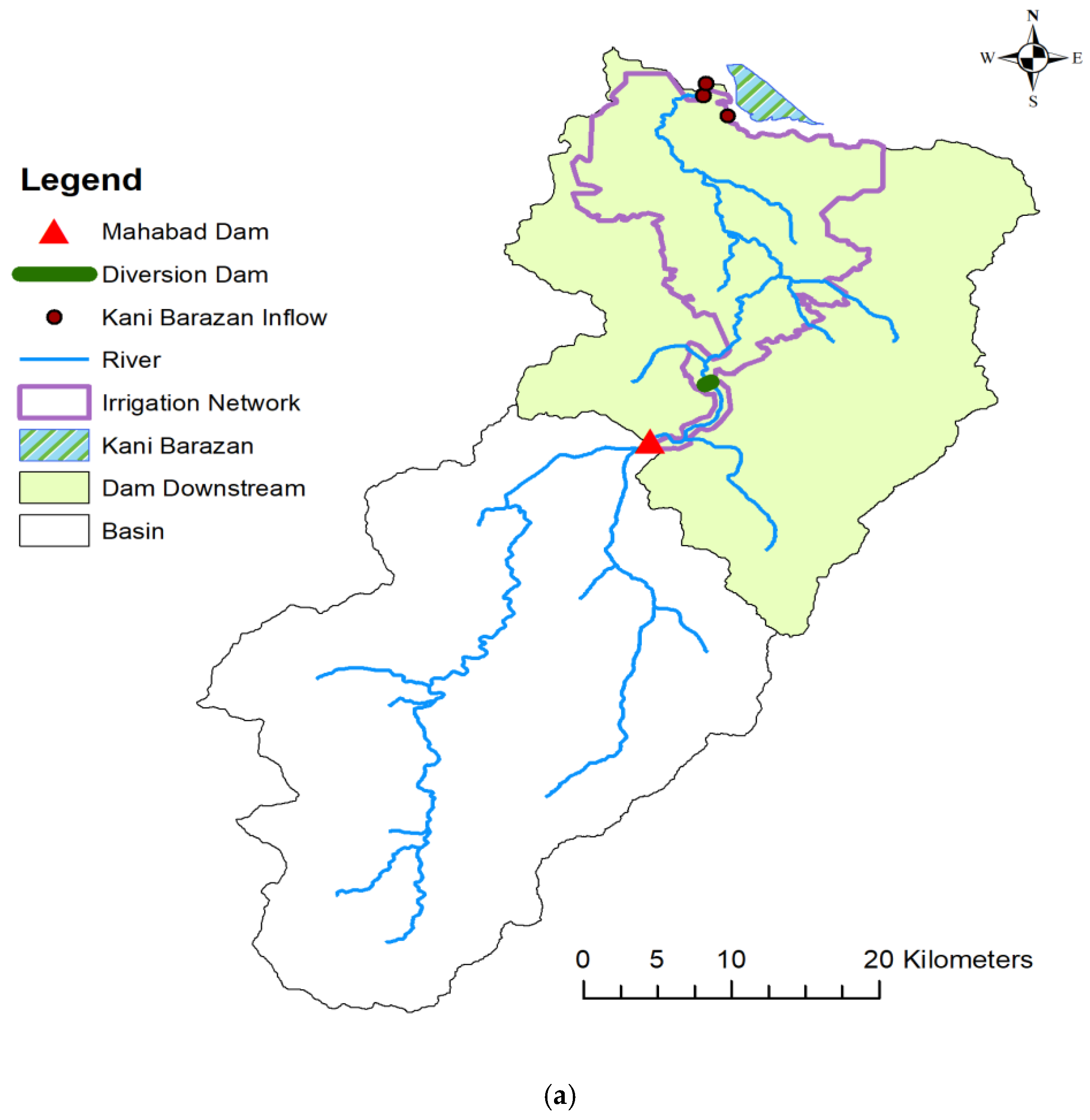
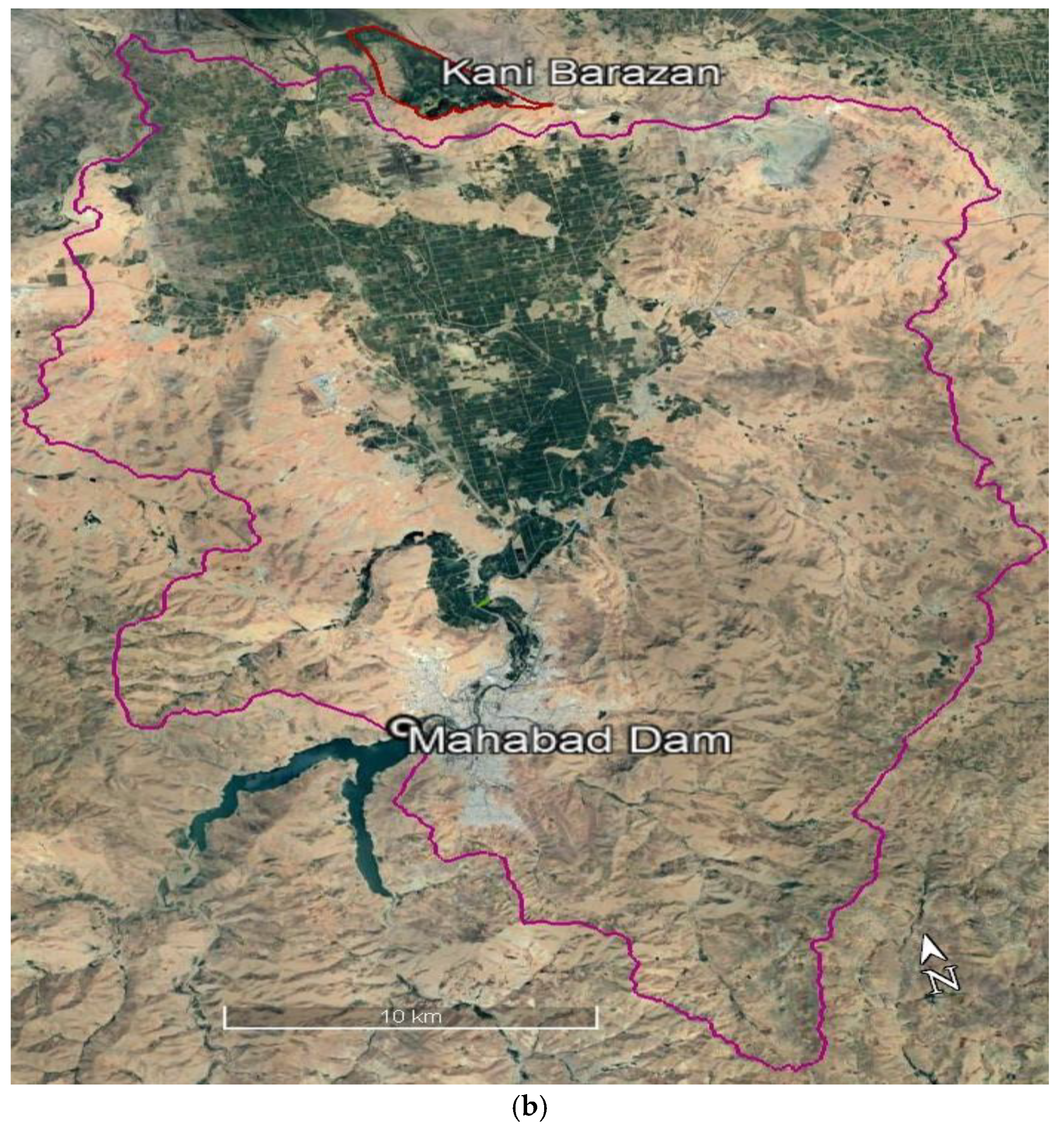
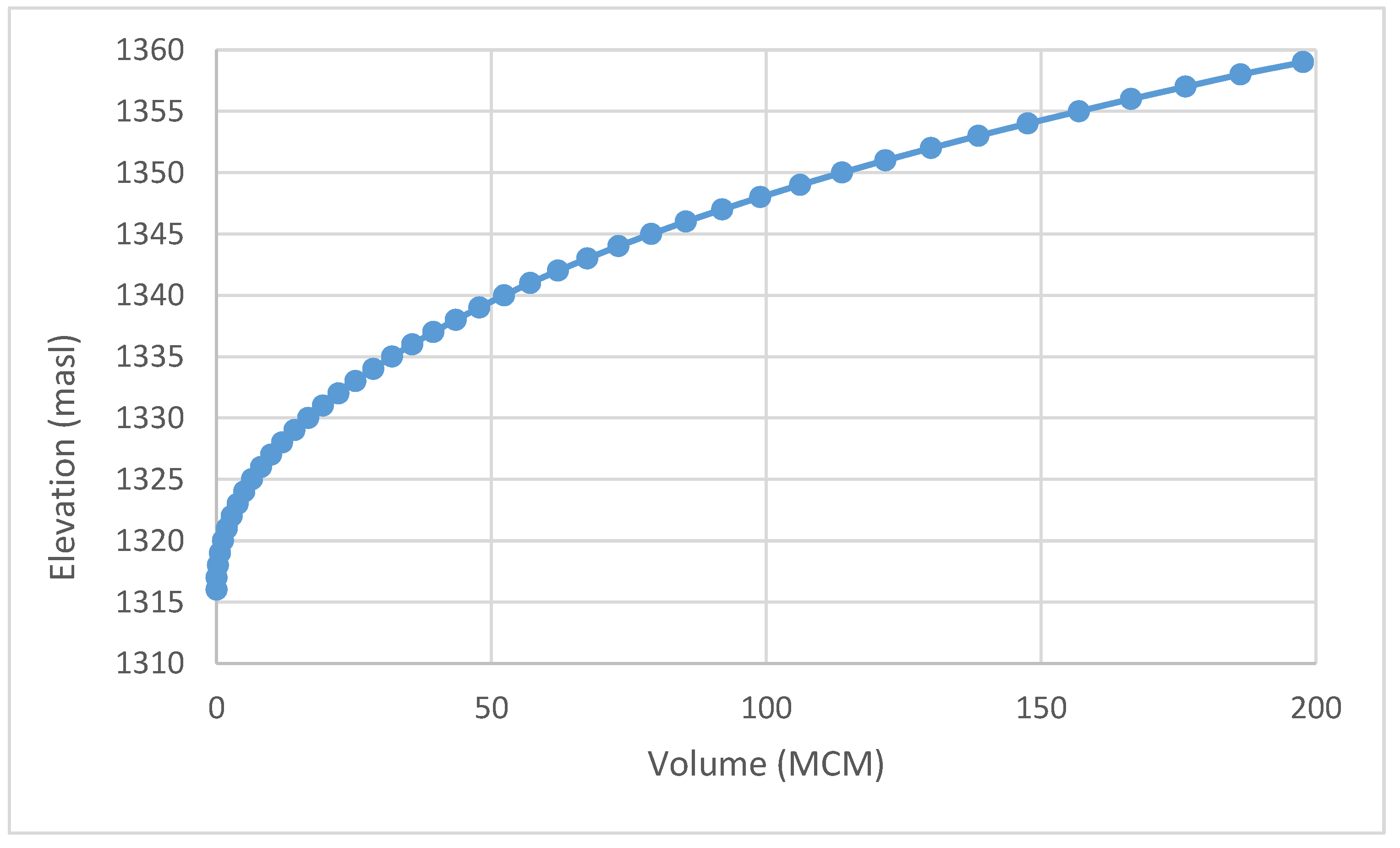
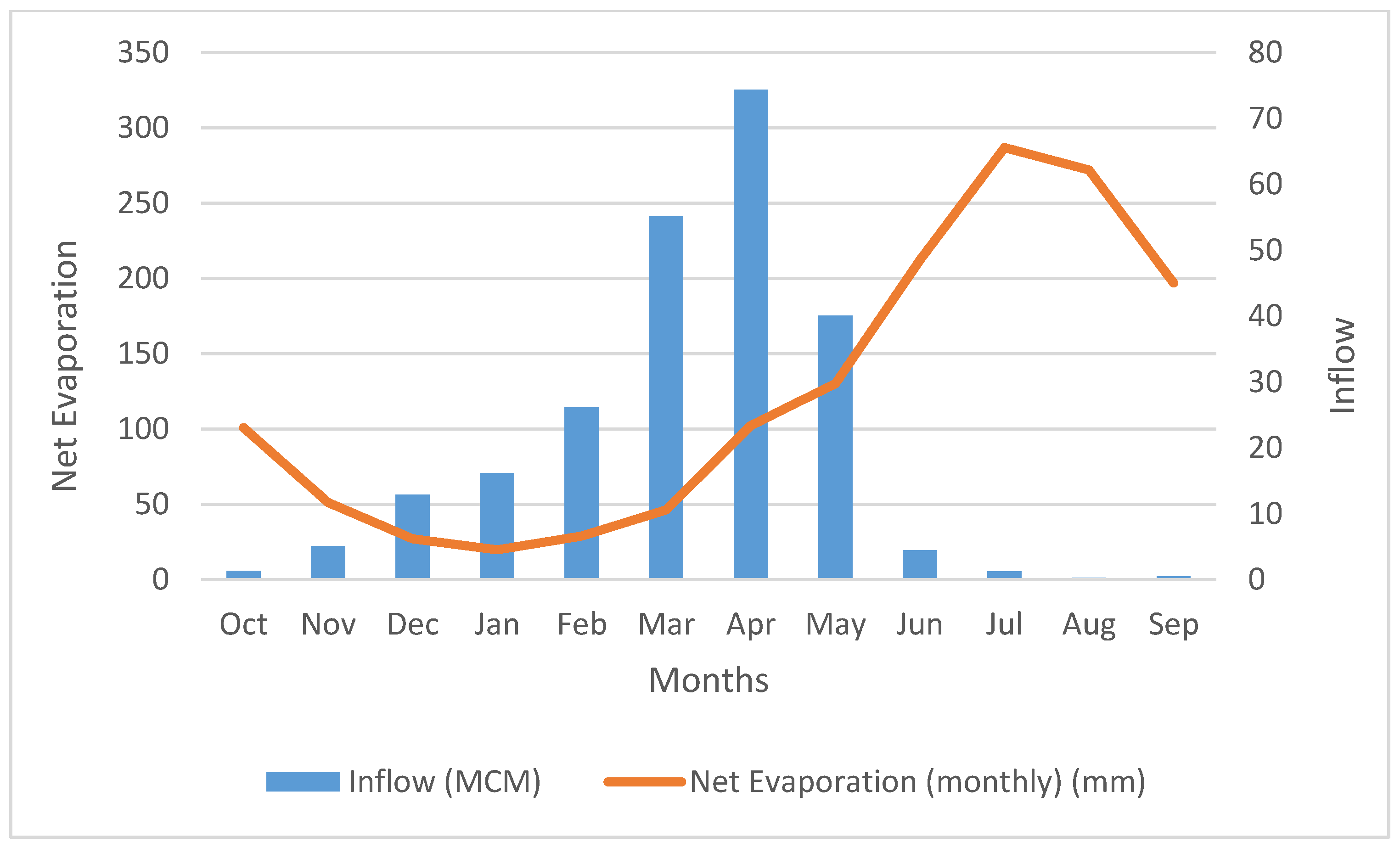


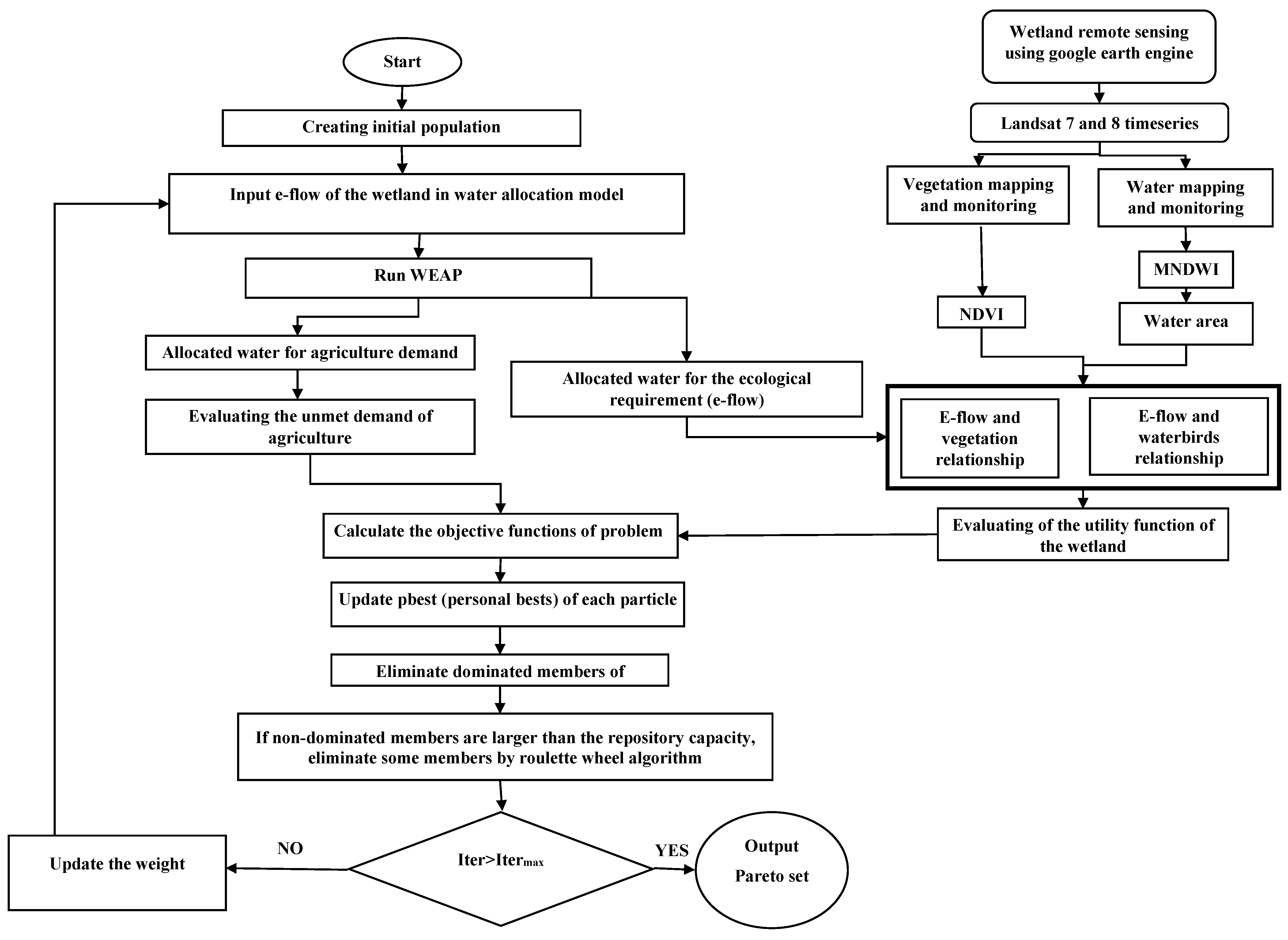
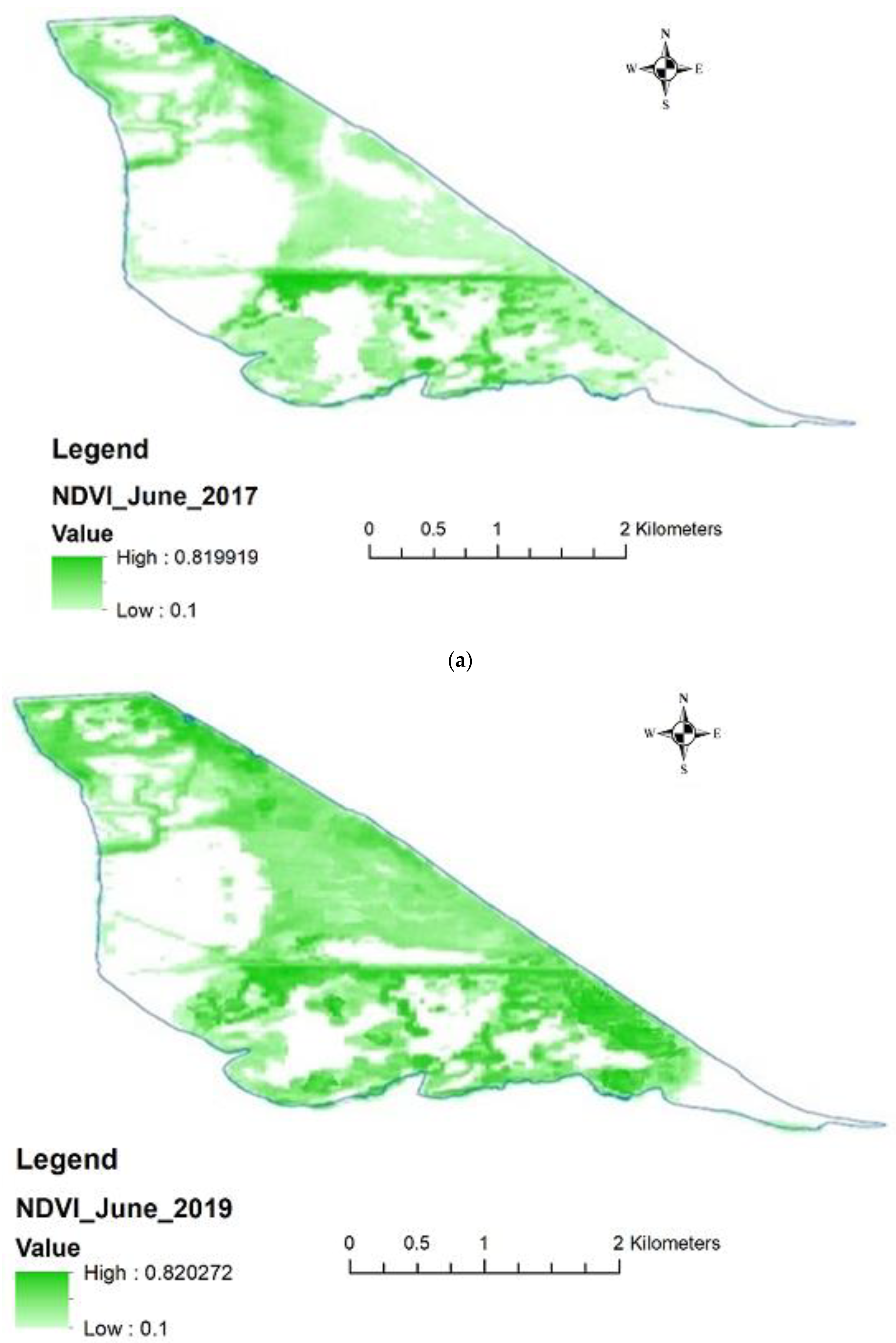
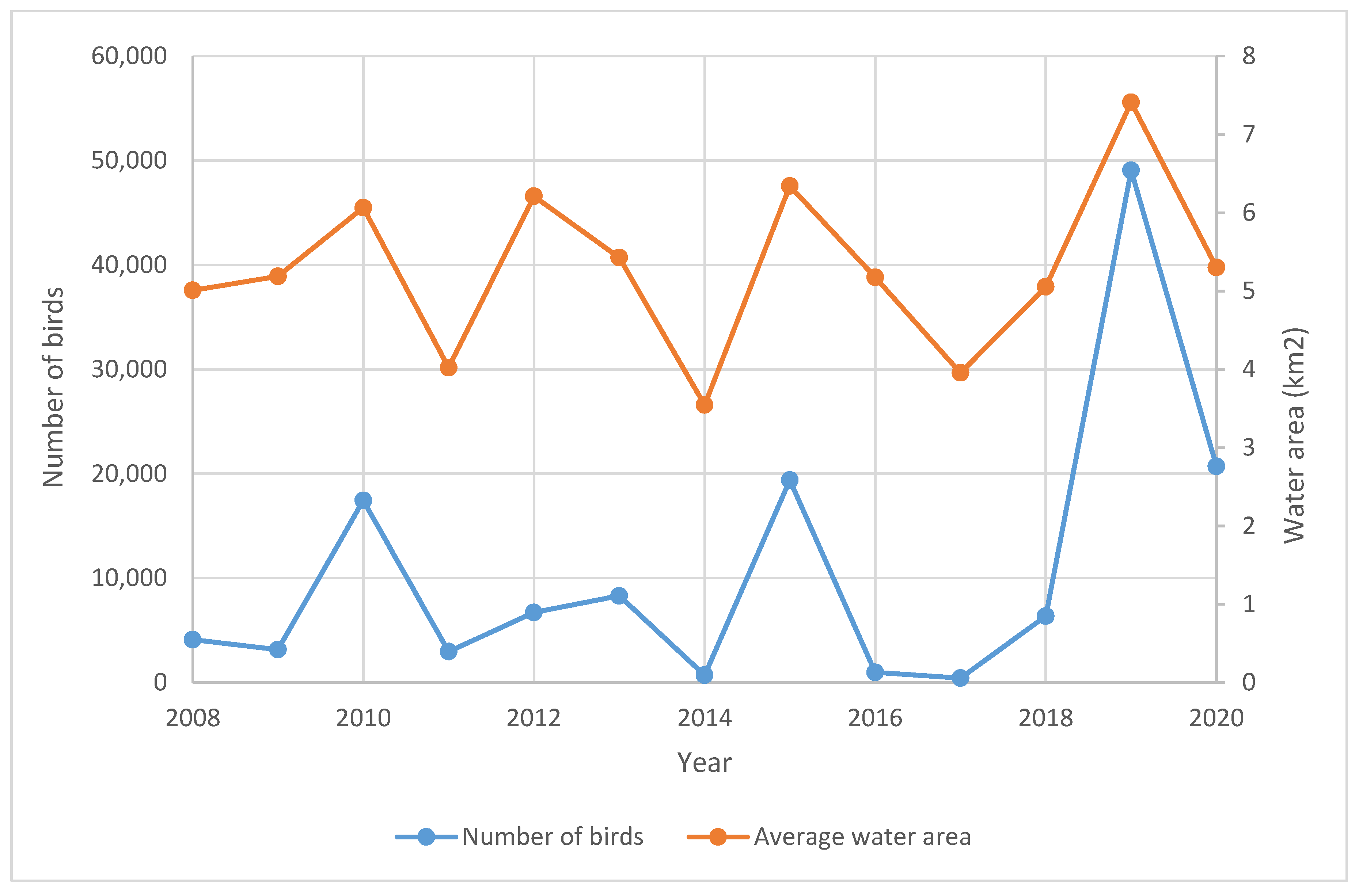
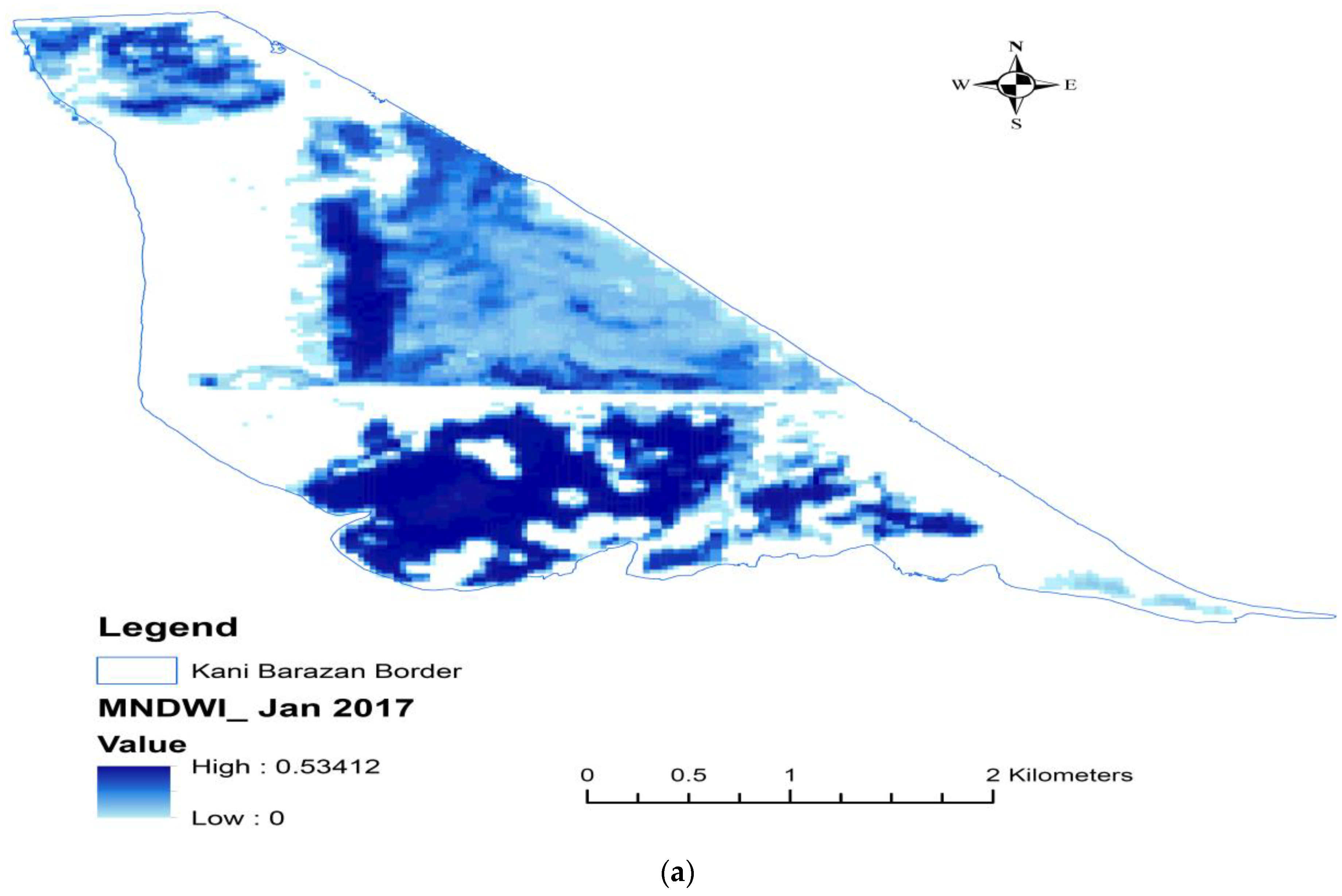
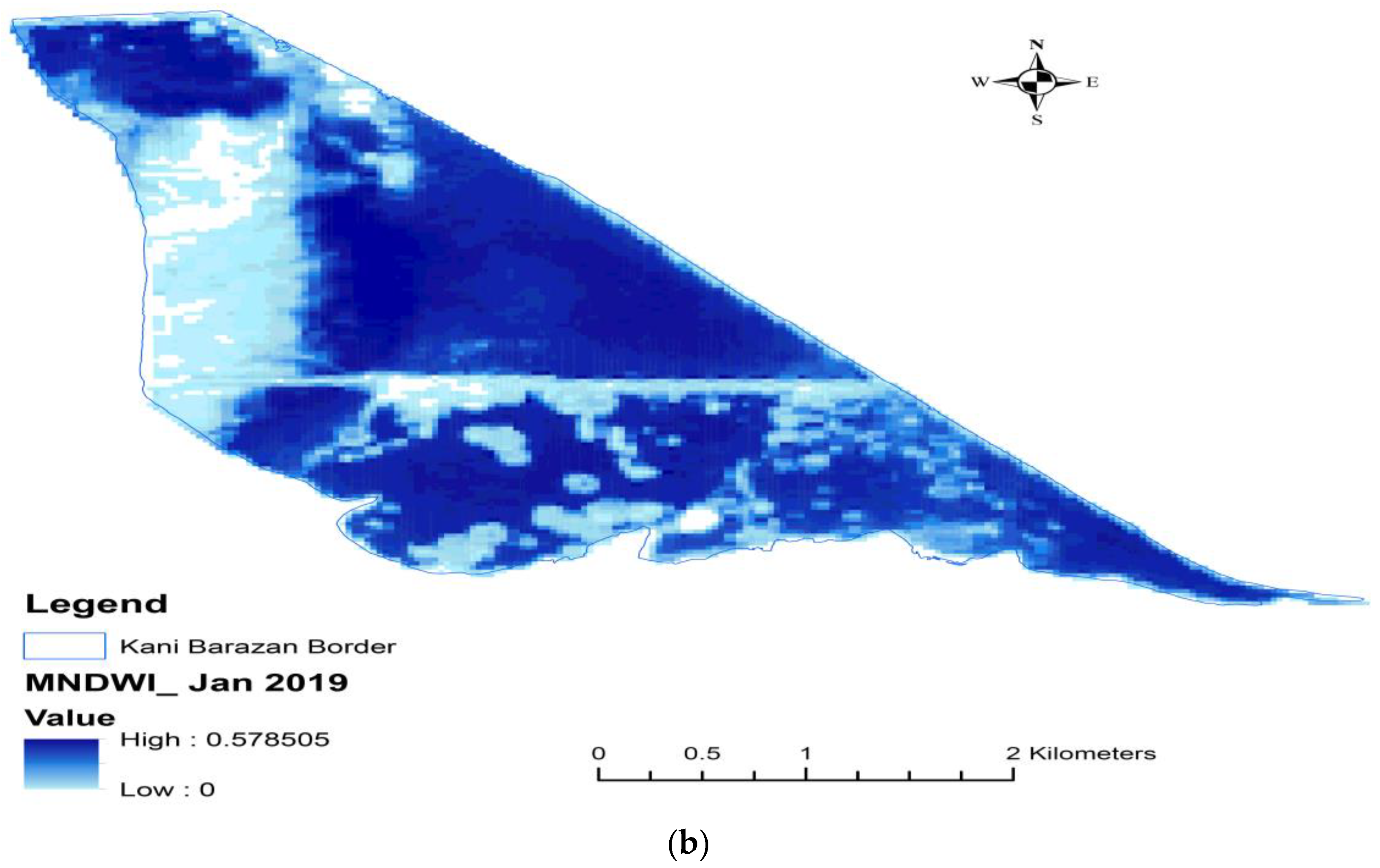
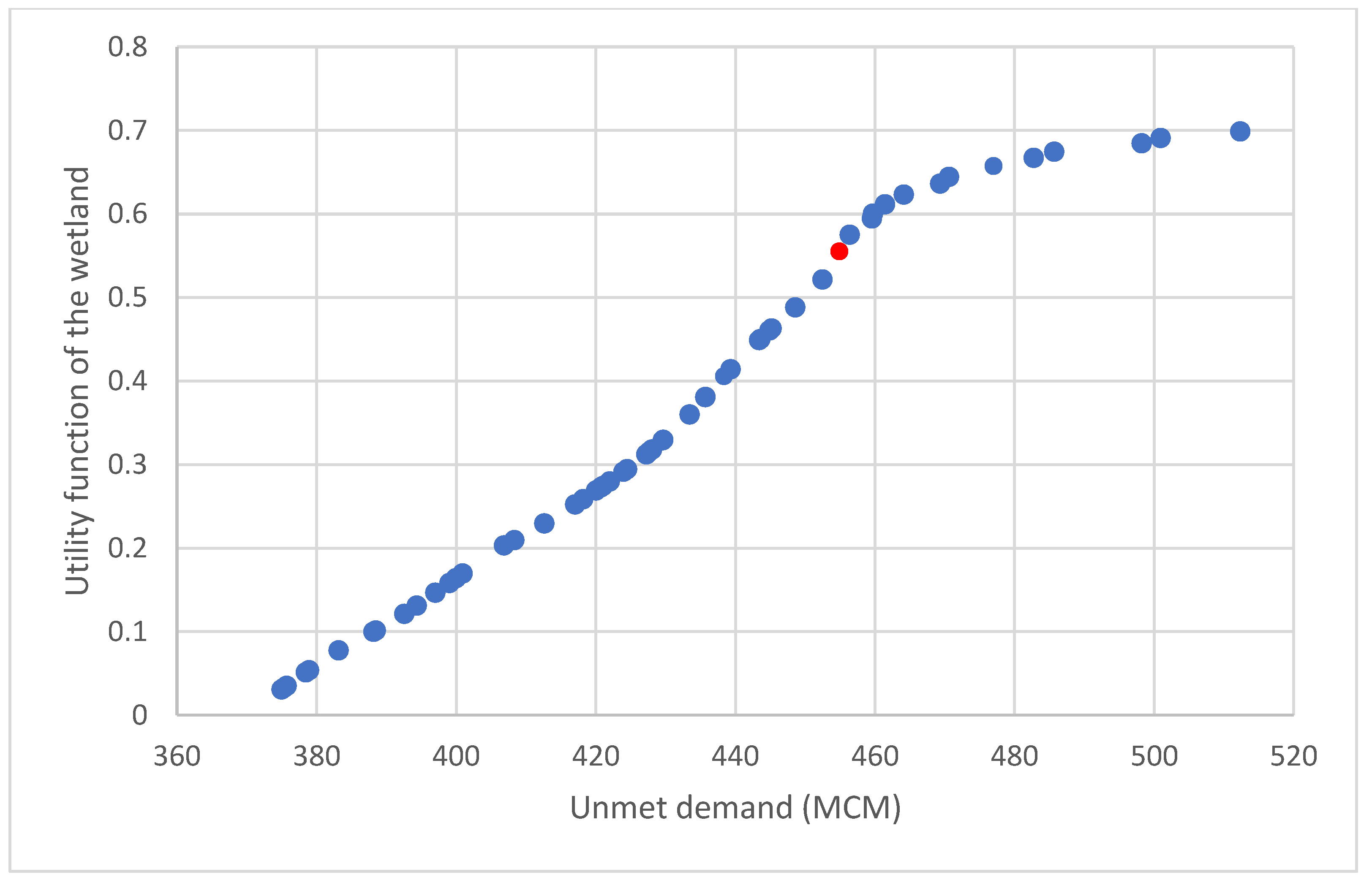

| Parameter | Value |
|---|---|
| 1 | |
| 0.9 | |
| 0.4 | |
| 1.8 | |
| 1.8 |
| Variables | Standard Error | t Stat | p-Value | Significance F | Multiple R | R Square |
|---|---|---|---|---|---|---|
| X Variable 1 (NDVI) | 1799.3243 | 5.3159 | 0.0003 | 0.0004 | 0.8875 | 0.7876 |
| X Variable 2 (Water area) | 34163.0672 | 2.2676 | 0.0468 |
Disclaimer/Publisher’s Note: The statements, opinions and data contained in all publications are solely those of the individual author(s) and contributor(s) and not of MDPI and/or the editor(s). MDPI and/or the editor(s) disclaim responsibility for any injury to people or property resulting from any ideas, methods, instructions or products referred to in the content. |
© 2023 by the authors. Licensee MDPI, Basel, Switzerland. This article is an open access article distributed under the terms and conditions of the Creative Commons Attribution (CC BY) license (https://creativecommons.org/licenses/by/4.0/).
Share and Cite
Hatamkhani, A.; Moridi, A. A Simulation Optimization Approach for Wetland Conservation and Management in an Agricultural Basin. Sustainability 2023, 15, 13926. https://doi.org/10.3390/su151813926
Hatamkhani A, Moridi A. A Simulation Optimization Approach for Wetland Conservation and Management in an Agricultural Basin. Sustainability. 2023; 15(18):13926. https://doi.org/10.3390/su151813926
Chicago/Turabian StyleHatamkhani, Amir, and Ali Moridi. 2023. "A Simulation Optimization Approach for Wetland Conservation and Management in an Agricultural Basin" Sustainability 15, no. 18: 13926. https://doi.org/10.3390/su151813926
APA StyleHatamkhani, A., & Moridi, A. (2023). A Simulation Optimization Approach for Wetland Conservation and Management in an Agricultural Basin. Sustainability, 15(18), 13926. https://doi.org/10.3390/su151813926






